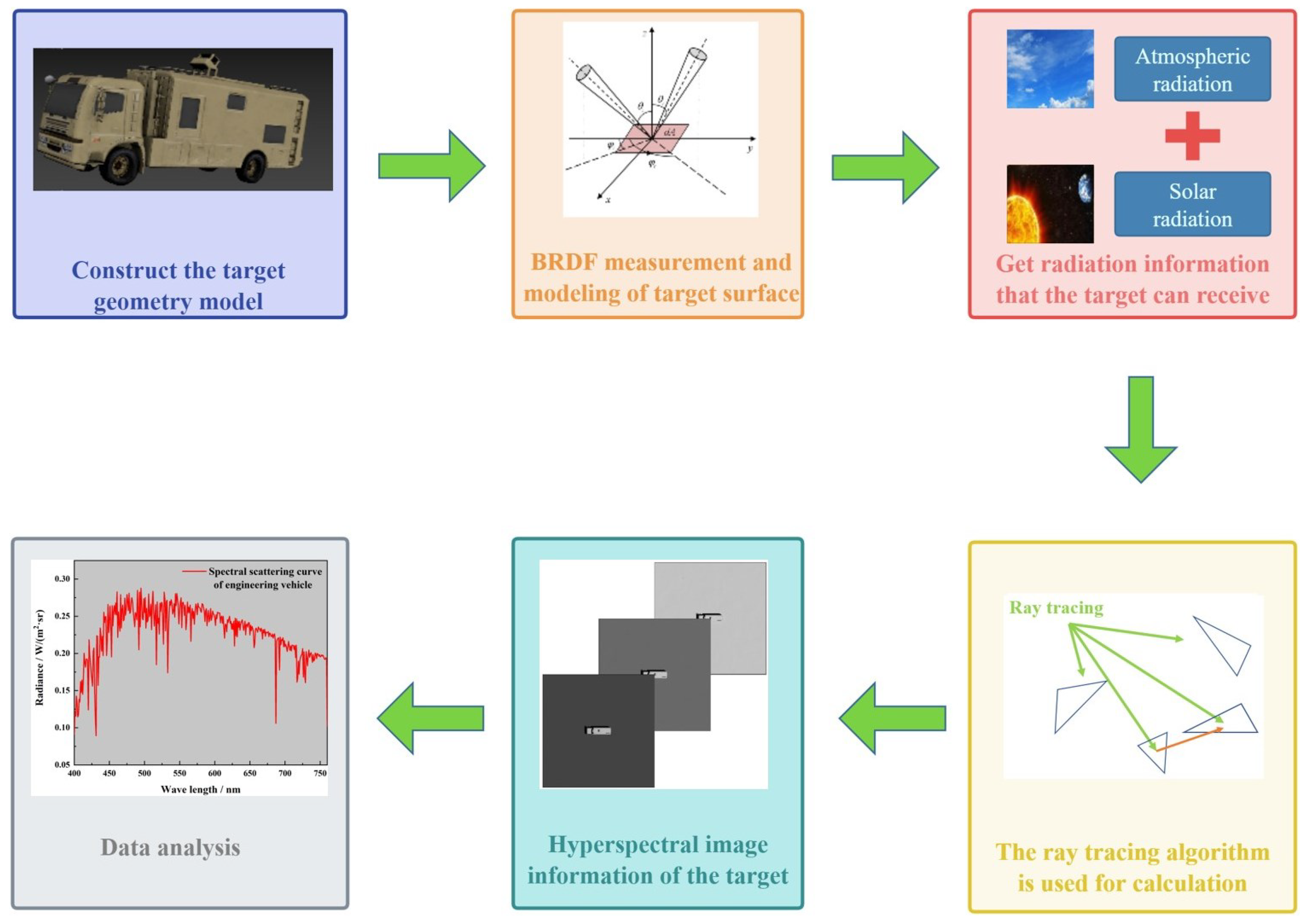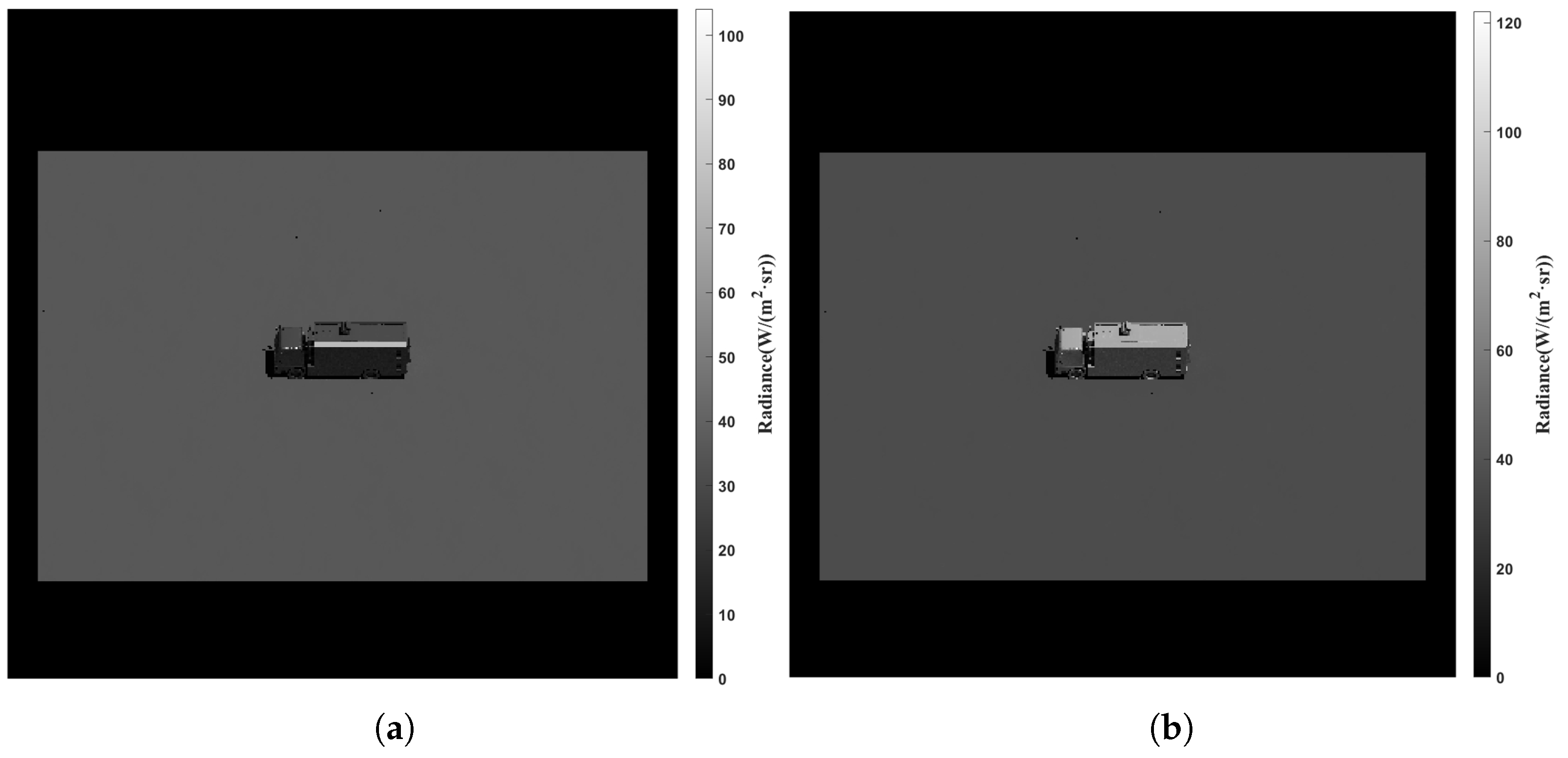A Calculation Method for the Hyperspectral Imaging of Targets Utilizing a Ray-Tracing Algorithm
Abstract
:1. Introduction
2. Methodology
2.1. Computation of Scattering Characteristics Utilizing the Ray-Tracing Method
2.2. Sampling and Optimizing Multiple Scatterings
2.3. Measurement and Modeling of BRDF
3. Analysis and Results
3.1. Spectral BRDF of Some Materials
3.2. Spectral Radiation of Sunlight and Atmosphere
3.3. Algorithm Accuracy Verification
4. Discussion
4.1. Geometric Model of the Target
- band1: 620–670 nm;
- band2: 841–846 nm;
- band3: 459–479 nm;
- band4: 545–565 nm.
4.2. Hyperspectral Imaging of the Target
4.2.1. The Outcomes under Various Observation Angles
4.2.2. The Outcomes for Different Paint Types
4.2.3. The Outcomes of Sunlight Scattering, Atmospheric Scattering, and Multiple Scatterings
5. Conclusions
Author Contributions
Funding
Data Availability Statement
Acknowledgments
Conflicts of Interest
Abbreviations
| BRDF | Bidirectional reflection distribution function |
References
- Zhang, L.; Lu, H.; Zhang, H.; Zhao, Y.; Xu, H.; Wang, J. Hyper-Spectral Characteristics in Support of Object Classification and Verification. IEEE Access 2019, 7, 119420–119429. [Google Scholar] [CrossRef]
- Li, L.; Gao, J.; Ge, H.; Zhang, Y.; Zhang, H. An effective feature extraction method via spectral-spatial filter discrimination analysis for hyperspectral image. Multimed. Tools Appl. 2022, 81, 40871–40904. [Google Scholar] [CrossRef]
- Wang, J.; Nian, F.; Chen, Z.; Liu, G. A calculation method for Spatially Varying Bidirectional Reflection Factor of target based on hyper-spectral image sequence. Opt. Commun. 2021, 482, 126598. [Google Scholar] [CrossRef]
- Stević, D.; Hut, I.; Dojčinović, N.; Joković, J. Automated identification of land cover type using multispectral satellite images. Energy Build. 2016, 115, 131–137. [Google Scholar] [CrossRef]
- Suresh, S.; Lal, S. A metaheuristic framework based automated Spatial-Spectral graph for land cover classification from multispectral and hyperspectral satellite images. Infrared Phys. Technol. 2020, 105, 103172. [Google Scholar] [CrossRef]
- Awad, M.M.; Lauteri, M. Self-Organizing Deep Learning (SO-UNet)—A Novel Framework to Classify Urban and Peri-Urban Forests. Sustainability 2021, 13, 5548. [Google Scholar] [CrossRef]
- Park, J.J.; Park, K.A.; Kim, T.S.; Oh, S.; Lee, M. Aerial hyperspectral remote sensing detection for maritime search and surveillance of floating small objects. Adv. Space Res. 2023, 72, 2118–2136. [Google Scholar] [CrossRef]
- Pudełko, A.; Chodak, M.; Roemer, J.; Uhl, T. Application of FT-NIR spectroscopy and NIR hyperspectral imaging to predict nitrogen and organic carbon contents in mine soils. Measurement 2020, 164, 108117. [Google Scholar] [CrossRef]
- Bhujade, V.G.; Sambhe, V. Role of digital, hyper spectral, and SAR images in detection of plant disease with deep learning network. Multimed. Tools Appl. 2022, 81, 33645–33670. [Google Scholar] [CrossRef]
- Salve, P.; Yannawar, P.; Sardesai, M. Multimodal plant recognition through hybrid feature fusion technique using imaging and non-imaging hyper-spectral data. J. King Saud Univ.-Comput. Inf. Sci. 2022, 34, 1361–1369. [Google Scholar] [CrossRef]
- Sathiyamoorthi, V.; Harshavardhanan, P.; Azath, H.; Senbagavalli, M.; Viswa Bharathy, A.M.; Chokkalingam, B.S. An effective model for predicting agricultural crop yield on remote sensing hyper-spectral images using adaptive logistic regression classifier. Concurr. Comput. Pract. Exp. 2022, 34, e7242. [Google Scholar] [CrossRef]
- Park, K.; ki Hong, Y.; hwan Kim, G.; Lee, J. Classification of apple leaf conditions in hyper-spectral images for diagnosis of Marssonina blotch using mRMR and deep neural network. Comput. Electron. Agric. 2018, 148, 179–187. [Google Scholar] [CrossRef]
- Tian, C.; Su, W.; Huang, S.; Shao, B.; Li, X.; Zhang, Y.; Wang, B.; Yu, X.; Li, W. Identification of gastric cancer types based on hyperspectral imaging technology. J. Biophotonics 2023, 17, e202300276. [Google Scholar] [CrossRef] [PubMed]
- Yarbrough, S.; Caudill, T.R.; Kouba, E.T.; Osweiler, V.; Arnold, J.; Quarles, R.; Russell, J.; Otten III, L.J.; Al Jones, B.; Edwards, A.; et al. MightySat II. 1 hyperspectral imager: Summary of on-orbit performance. In Imaging Spectrometry VII; SPIE: Philadelphia, PA, USA, 2002; Volume 4480, pp. 186–197. [Google Scholar]
- Fort, D.; Warren, J.; Strohbehn, K.; Murchie, S.; Heyler, G.; Peacock, K.; Boldt, J.; Darlington, E.; Hayes, J.; Henshaw, R.; et al. The CONTOUR remote imager and spectrograph. Acta Astronaut. 2003, 52, 427–431. [Google Scholar] [CrossRef]
- Teillet, P.; Fedosejevs, G.; Gauthier, R. Operational radiometric calibration of broadscale satellite sensors using hyperspectral airborne remote sensing of prairie rangeland: First trials. Metrologia 1998, 35, 639. [Google Scholar] [CrossRef]
- Huang, Z.; Chen, Q.; Chen, Q.; Liu, X.; He, H. A Novel Hyperspectral Image Simulation Method Based on Nonnegative Matrix Factorization. Remote Sens. 2019, 11, 2416. [Google Scholar] [CrossRef]
- Li, X.; Yuan, Y.; Wang, Q. Hyperspectral and multispectral image fusion based on band simulation. IEEE Geosci. Remote Sens. Lett. 2019, 17, 479–483. [Google Scholar] [CrossRef]
- Chen, F.; Niu, Z.; Sun, G.; Wang, C.; Teng, J. Using low-spectral-resolution images to acquire simulated hyperspectral images. Int. J. Remote Sens. 2008, 29, 2963–2980. [Google Scholar] [CrossRef]
- Chen, H.; Du, X.; Liu, Z.; Cheng, X.; Zhou, Y.; Zhou, B. Target recognition algorithm for fused hyperspectral image by using combined spectra. Spectrosc. Lett. 2015, 48, 251–258. [Google Scholar] [CrossRef]
- Moncet, J.L.; Uymin, G.; Lipton, A.E.; Snell, H.E. Infrared radiance modeling by optimal spectral sampling. J. Atmos. Sci. 2008, 65, 3917–3934. [Google Scholar] [CrossRef]
- Su, M.; Liu, C.; Di, D.; Le, T.; Sun, Y.; Li, J.; Lu, F.; Zhang, P.; Sohn, B.J. A Multi-Domain Compression Radiative Transfer Model for the Fengyun-4 Geosynchronous Interferometric Infrared Sounder (GIIRS). Adv. Atmos. Sci. 2023, 40, 1844–1858. [Google Scholar] [CrossRef]
- Liu, X.; Yang, Q.; Li, H.; Jin, Z.; Wu, W.; Kizer, S.; Zhou, D.K.; Yang, P. Development of a fast and accurate PCRTM radiative transfer model in the solar spectral region. Appl. Opt. 2016, 55, 8236–8247. [Google Scholar] [CrossRef] [PubMed]
- Guo, X.; Wu, Z.; Wu, J.; Cao, Y. Study of infrared reflection characteristics of aerial target using MODIS data on GPU. J. Real-Time Image Process. 2018, 15, 643–655. [Google Scholar] [CrossRef]
- García-Santos, V.; Coll, C.; Valor, E.; Niclòs, R.; Caselles, V. Analyzing the anisotropy of thermal infrared emissivity over arid regions using a new MODIS land surface temperature and emissivity product (MOD21). Remote Sens. Environ. 2015, 169, 212–221. [Google Scholar] [CrossRef]
- Cao, Y.; Wu, Z.; Zhang, H.; Wei, Q.; Wang, S. Experimental Measurement and Statistical Modeling of Spectral Bidirectional Reflectance Distribution Function of Rough Target Samples. Ph.D. Thesis, Shanghai University of Electric Power, Shanghai, China, 2008. [Google Scholar]
- Chen, B.; Cheng, H.H. Interpretive OpenGL for computer graphics. Comput. Graph. 2005, 29, 331–339. [Google Scholar] [CrossRef]
- Han, Y.; Lin, L.; Sun, H.; Jiang, J.; He, X. Modeling the space-based optical imaging of complex space target based on the pixel method. Optik 2015, 126, 1474–1478. [Google Scholar] [CrossRef]
- Yu, C.; Zhang, H.; Zheng, G. Research on infrared imaging simulation technology of ocean scene. In AOPC 2021: Optical Sensing and Imaging Technology; SPIE: Philadelphia, PA, USA, 2021; Volume 12065, pp. 255–259. [Google Scholar]
- Han, Y.; Sun, H.; Li, Y.; Guo, H. Fast calculation method of complex space targets’ optical cross section. Appl. Opt. 2013, 52, 4013–4019. [Google Scholar] [CrossRef] [PubMed]
- Han, Y.; Sun, H.; Guo, H. Analysis of influential factors on a space target’s laser radar cross-section. Opt. Laser Technol. 2014, 56, 151–157. [Google Scholar] [CrossRef]
- Zhang, Y.; Lv, L.; Yang, C.; Gu, Y. Research on digital imaging simulation method of space target navigation camera. In Proceedings of the 2021 IEEE 16th Conference on Industrial Electronics and Applications (ICIEA), Chengdu, China, 1–4 August 2021; IEEE: New York, NY, USA, 2021; pp. 1643–1648. [Google Scholar]
- Arnold, P.S.; Brown, S.D.; Schott, J.R. Hyperspectral simulation of chemical weapon dispersal patterns using DIRSIG. In Targets and Backgrounds VI: Characterization, Visualization, and the Detection Process; SPIE: Philadelphia, PA, USA, 2000; Volume 4029, pp. 288–299. [Google Scholar]
- Börner, A.; Wiest, L.; Keller, P.; Reulke, R.; Richter, R.; Schaepman, M.; Schläpfer, D. SENSOR: A tool for the simulation of hyperspectral remote sensing systems. ISPRS J. Photogramm. Remote Sens. 2001, 55, 299–312. [Google Scholar] [CrossRef]
- Goodenough, A.A.; Brown, S.D. DIRSIG5: Next-generation remote sensing data and image simulation framework. IEEE J. Sel. Top. Appl. Earth Obs. Remote Sens. 2017, 10, 4818–4833. [Google Scholar] [CrossRef]
- Zhang, J.; Zhang, X.; Zou, B.; Chen, D. On hyperspectral image simulation of a complex woodland area. IEEE Trans. Geosci. Remote Sens. 2010, 48, 3889–3902. [Google Scholar] [CrossRef]
- Sun, D.; Gao, J.; Sun, K.; Hu, Y.; Li, Y.; Xie, J.; Zhang, L. Research on hyperspectral dynamic scene and image sequence simulation. In Hyperspectral Remote Sensing Applications and Environmental Monitoring and Safety Testing Technology; SPIE: Philadelphia, PA, USA, 2016; Volume 10156, pp. 323–330. [Google Scholar]
- Cao, Y.; Cao, Y.; Li, W.; Bai, L.; Wu, Z.; Wang, Z. Optimization of ray tracing algorithm for laser radar cross section calculation based on material bidirectional reflection distribution function. Opt. Commun. 2021, 500, 127207. [Google Scholar] [CrossRef]
- Culpepper, M.A. Empirical bidirectional reflectivity model. In Targets and Backgrounds: Characterization and Representation; SPIE: Philadelphia, PA, USA, 1995; Volume 2469, pp. 208–219. [Google Scholar]
- Wu, Z. Experimental study on bidirectional reflectance distribution function of laser scattering from various rough surfaces. Acta Opt. Sin. 1996, 16, 262–268. [Google Scholar]
- Zhang, H.; Wu, Z.; Cao, Y.; Zhang, G. Measurement and statistical modeling of BRDF of various samples. Opt. Appl. 2010, 40, 197–208. [Google Scholar]
- Hua, Y.; Xiao, L.I.; Feng, G. An Algorithm for the Retrieval of Albedo from Space Using New GO Kernel-Driven BRDF Model. J. Remote Sens. 2002, 6, 246–251. [Google Scholar]




















| Wavelength (nm) | b | a | |||
|---|---|---|---|---|---|
| 400 | |||||
| 401 | |||||
| … | … | … | … | … | … |
| … | … | … | … | … | … |
| 759 | |||||
| 760 |
| Core Weight | Band1 | Band2 | Band3 | Band4 |
|---|---|---|---|---|
Disclaimer/Publisher’s Note: The statements, opinions and data contained in all publications are solely those of the individual author(s) and contributor(s) and not of MDPI and/or the editor(s). MDPI and/or the editor(s) disclaim responsibility for any injury to people or property resulting from any ideas, methods, instructions or products referred to in the content. |
© 2024 by the authors. Licensee MDPI, Basel, Switzerland. This article is an open access article distributed under the terms and conditions of the Creative Commons Attribution (CC BY) license (https://creativecommons.org/licenses/by/4.0/).
Share and Cite
Cao, Y.; Cao, Y.; Wu, Z.; Yang, K. A Calculation Method for the Hyperspectral Imaging of Targets Utilizing a Ray-Tracing Algorithm. Remote Sens. 2024, 16, 1779. https://doi.org/10.3390/rs16101779
Cao Y, Cao Y, Wu Z, Yang K. A Calculation Method for the Hyperspectral Imaging of Targets Utilizing a Ray-Tracing Algorithm. Remote Sensing. 2024; 16(10):1779. https://doi.org/10.3390/rs16101779
Chicago/Turabian StyleCao, Yisen, Yunhua Cao, Zhensen Wu, and Kai Yang. 2024. "A Calculation Method for the Hyperspectral Imaging of Targets Utilizing a Ray-Tracing Algorithm" Remote Sensing 16, no. 10: 1779. https://doi.org/10.3390/rs16101779







